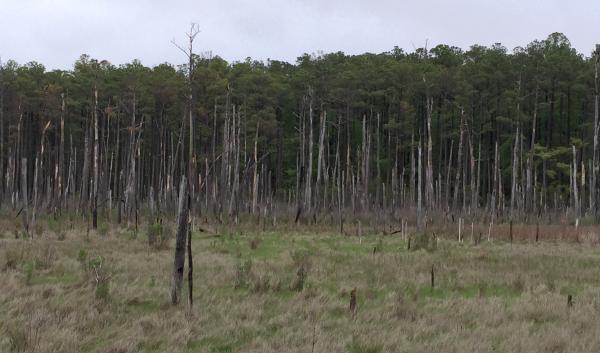Saltwater flooding, due to sea level rise and more frequent and intense storm events, has become an increasing problem for farmers near coastal lands. (Bay Journal, March 2019).
The Mid-Atlantic States of the eastern U.S. are being especially affected by coastal flooding due to both increasing rates of sea level rise and land subsidence. The average rate of sea level rise for this geographic area is estimated at three times the global average, according to a USGS study (Sallenger et al., Nature Climate Change, 2012). The USDA Northeast Climate Hub is working with researchers at the USDA Natural Resources Conservation Service (NRCS), University of Maryland Agroecology Lab, and George Washington University, Department of Biological Sciences to better understand the impacts of saltwater flooding on farmland.
In parallel, climate change is also causing increasing temperatures that will most likely result in changes in plant tolerance and hardiness. This means that different plant species may need to be used as crops, cover crops, and for conservation practices (NRCS Climate Change Adaptation Plan, 2014). To compound the problem, there are also reports of water quality issues resulting from saltwater flooding. So far, UMD-led researchers have found that on the Lower Eastern Shore of Maryland (Delmarva Peninsula) coastal flooding by saltwater releases phosphorus and nitrogen from the soil affecting water quality in Chesapeake Bay (Tully, K. L., Weissman, D., Wyner, W. J., & Miller, J. 2019. Soils in transition: saltwater intrusion alters soil chemistry in agricultural fields. Biogeochemistry, 142(3), 339–356).
To combat this problem, Chris Miller, 2019 NRCS Climate Hub Liaison, is studying how farmers can use various adaptive management methods to deal with both the saltwater and water quality impacts.
Managing the impact of saltwater flooding will require producers to use different farming methods. With better field evaluation methods and use of appropriate conservation practices, producers in impacted areas may not need to completely abandon affected fields. However, in some cases, wetland easements may be the best, or only, option. This would result in cropland being converted to wetlands either through natural regeneration or planned wetland creation. The benefit to the producer would be a one-time acreage payment for the land acquisition (Agricultural Easement Program, 2018 Farm Bill). An ecosystem benefit to converting salt-affected cropland into wetlands would be the additional floodwater storage that may help protect and buffer adjacent crop fields. Another possibility could be to grow value-added, niche conservation plants on these marginal lands that may produce some income as well as provide valuable ecosystem services.
For example, native salt meadow cordgrass or salt hay was historically harvested from the natural tidal marsh and used as feed hay and mulch. This mulch is highly valued as it is relatively weed free. However, most of these “farmed” wetland areas on the East Coast can no longer be harvested due to sea level rise and storm damage to dikes and levees through the years. Opportunities now exist for farmers to plant a crop of salt meadow cordgrass in the marginal, salt-impacted fields.
These marginal lands might have once had typical crops, but are now no longer productive due to periodic flooding and an increase of salt. These are now the perfect conditions for salt meadow cordgrass to thrive.
Another option where potential markets exist is to establish streamside or shoreline buffers of deep rooted native warm season grasses and wetland forbs to be harvested for biomass. These buffers would help provide ecosystem services for erosion control, water quality improvement, and wildlife habitat. The chopped, dormant stems of warm season native grasses such as switchgrass, coastal panicgrass, prairie cordgrass, and eastern gamagrass have highly absorbent fibers, which are proving to be very useful for animal bedding. Research at the Pennsylvania State University and University of Delaware has shown these warm season grass residues to be more absorbent than sawdust, which has been the industry standard for animal bedding. The poultry industry on the Delmarva Peninsula, for example, is very interested in expanding the local production of native grasses for use as poultry house bedding material. This more absorbent native grass bedding has been shown to result in less foot pad diseases on the chickens due to drier surface conditions. These same materials are also being marketed as a cat litter product. In addition, the chopped stems of these grasses are in various absorbent material products used in the erosion control and natural gas industries. So, potential markets currently exist and are continuing to develop using plant-derived products of species that will grow in salt-affected soils.
For agriculture along coastal waters to remain economically viable, producers will need to meet many challenges. This will likely mean establishing appropriate Best Management Practices, planting salt-adapted crops, and using other innovative management strategies in this harsh environment.
In addition, due to the potential release of nutrients by saltwater flooding, it will be important for producers to consider planting species that provide for water quality improvement. A reliable partner that producers can turn to for help is NRCS. This USDA agency recommends a host of conservation practices to help solve natural resource problems on farms. Their Climate Change Adaptation Plan speaks to the significant salt impacts producers are, and will likely continue to, face from sea level rise, and greater storm frequency and intensity. Land managers can expect to soon see more salt-tolerant species added into many of the vegetative planting practices (such as Herbaceous Riparian Buffers, Filter Strips, Streambank and Shoreline Protection, Cover Crop, Conservation Cover, and Critical Area Planting) in the NRCS’ Field Office Technical Guide.



